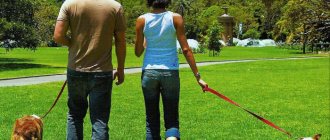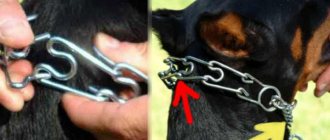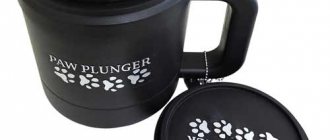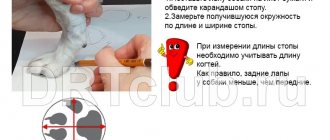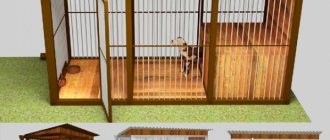Greetings to all do-it-yourselfers, as well as dog breeders!
Today I want to share an idea for making a very simple, homemade choke leash for training young dogs and puppies.
I think every dog owner knows that any dog (both large and small) must have certain training skills and obedience to the owner. Moreover, this does not mean at all that every dog needs to be intensively trained and undergo a GCD (general training course).
If the dog is not a service dog, but is kept in the family simply as a pet and friend, then the ability to walk on a leash and knowledge of at least two basic commands: “stay” and “come to me” is enough for it. This alone makes the dog manageable and obedient, and on occasion it can simply save its life, especially in the dangerous conditions of a big city.
At the same time, it is advisable to begin raising a dog from puppyhood. Well, in order to facilitate and speed up the upbringing and training of a dog, it is very good to use a special device in the form of a leash with a strict collar or a choke collar.
It must be said that there are now a huge number of different strict collars on sale. Moreover, the basis of all these collars is the property of tightening like a noose or noose with a sharp jerk, which naturally has a certain effect on the dog.
However, such collars are often quite expensive. But at the same time, there is no particular point in buying them, since such a collar is needed only for the period of raising and training the dog.
For example, I have long been convinced that in ordinary cases, for the successful training of a dog, a very easy-to-make, homemade noose leash is quite suitable. Such a leash can be easily made in a few minutes, and it will cost almost nothing. At the same time, it can last for a very long time and with its help, you can raise more than one generation of dogs.
I've been using a similar leash for many years now. This is what he looks like.
As you can see, it can be made from ordinary rope.
Purpose of the noose leash
All dogs are different, each has its own special character. There are large dogs that behave very excitedly during walks, chasing every cat, dog or even bird. In this case, it is usually incredibly difficult for the owner to keep a large dog on a leash. It is for such dogs that a noose leash is needed, with the help of which the dog can be stopped without much difficulty. Moreover, this dog training collar fits very well.
ATTENTION! After using the choke for some time, the dog usually gets used to normal behavior and then the choke can be replaced with a regular collar.
How to make a dog leash with your own hands
A leash-noose or half-noose can be made at home. This does not require skill or much time, and the materials can be purchased at any hardware store.
DIY noose leash
You can make a noose leash yourself at home. To do this, you need to prepare the following materials:
The principle of making a figure eight leash for dogs:
DIY half-choke collar
Often dog owners believe that a choke collar can cause pain to their pet and instead of this accessory they purchase a half-choke leash. It is less traumatic for the dog’s psyche and is also easy to do at home. For this you will need:
Features of leash training for an adult dog
The stages of training an adult animal differ from those described earlier. If a dog has spent a long time in an enclosure or a kennel cage, its training begins with a leash about 8 meters long. Work with the dog in an open area, the leash should hang freely. The leash is shortened gradually as you get used to it. Usually an adult animal does not want to walk on a short leash. Treats are used for training. When luring the dog with a tasty morsel, they make sure that it does not run ahead and block the owner’s path.
One lesson with an adult dog should not exceed half an hour in duration.
Leash training an adult dog requires patience from the owner.
Existing types of dog leashes
Today, modern industry offers a wide selection of this essential attribute of dog equipment. Each owner can choose the accessory that suits his pet.
Roulette leash for dogs
Widely popular among pet owners, it is often called an automatic or retractable tape leash.
Roulettes are especially convenient for walking pets inside city streets and parks, as they allow you to quickly adjust the length of the retractable part, shorten or lengthen it in one movement.
They can be cable or tape. The cable is much cheaper, but is only suitable for small pets. In addition, in this case it is dangerous to touch the retractable part with bare hands; you can cut yourself.
If the retractable part is in the form of a tape, it is absolutely safe and reliable. Its length can be from three to ten meters.
The tape measure has a mechanism that allows you to fix the set length, so the tape cannot get tangled in your legs and paws and does not get dirty, since it does not touch the ground.
The dog moves freely, runs or walks next to the person. The length shortens or lengthens automatically; it does not need to be constantly monitored.
Returning from walking the pet and unfastening the leash from the collar, the owner simply presses a button and winds the tape or cable into the box, so it does not take up much space when stored.
The disadvantages of roulette leashes include their relative high cost, the inability to use for walking hyperactive pets, and the dog’s rapidly developing habit of constantly pulling on the tape.
It is important not to allow your pet to chew on the tape - it is not very strong and wears out quickly if it bends often. In addition, the locking mechanism sometimes jams, especially with frequent jerking and tugging, debris and dirt.
Show leash
This is an exclusively exhibition accessory intended for show class dogs. Usually it is expensive and beautiful, but at the same time it is not striking and does not distract the attention of the public and judges from the dog’s exterior.
Show rings can be very different in design, but usually consist of a carabiner and two loops, one of which is put on the dog athlete’s neck, and the other on the owner’s wrist.
This is a very convenient and beautiful accessory.
Leash controller for dogs
This type of leash is designed to correct the dog's behavior. In fact, it acts as a noose; thanks to its use, the pet will quickly wean itself from pulling and tugging on the harness, rushing towards other animals and picking up pieces of food.
With the help of a leash-controller, the dog quickly learns many commands, such as “near”, “sit”, “lie down”, “no”. At the same time, this accessory can be used as classic ammunition.
Typically, the clamp on the controller is made of rawhide with a high resistance force, which allows the cord to hold the load and not fray. The tape itself is made of high-strength and wear-resistant material with a maximum tensile strength of up to 900 kg. In addition, it does not stretch when stretched.
There is also a screw carabiner that allows you to attach the cord to a regular collar; the second end can be fixed to the owner’s waist belt. In this case, his hands remain free.
There are also leash-controller models with one lock. Thus, this is a very convenient accessory that allows you to use it as a classic leash and controller for correcting your pet’s behavioral reactions, such as aggression, disobedience and others. In this case, the animal does not experience pain or psychological pressure, and does not receive any harm.
Dog leash
The dog wears a noose without a collar; its role is played by a special loop. If the dog begins to twitch and pull, it immediately tightens, preventing the pet from breaking the rules.
Training a puppy using a choke collar
For some puppies, using a choke collar is a must. Still untrained puppies are distracted with the help of a noose from various external factors that interfere with training. If the noose is used wisely, it does not cause any harm to the dog, but it helps the owner cope with the still uncontrollable dog. When the dog jerks, the amount of incoming air decreases and this immediately moderates the ardor of a temperamental dog.
The noose itself looks like a regular collar, but it does not have a standard clasp. Instead there are restrictive rings. When putting the collar on the dog, it is passed through one ring and the loop is placed around the pet's neck. A leash is attached to the other ring. When it is not pulled, the collar is completely loose around the neck. As soon as the dog jerks, the leash tightens and the choke tightens, causing the dog to experience discomfort.
REFERENCE! There is also a noose collar with a lock or with three rings on sale. Their action is the same, only the third ring limits the size to which the collar can be tightened. Even with this diameter it will no longer tighten and certainly will not choke the dog.
What is a choke collar?
This is a collar with two restrictive rings instead of a clasp.
It works like this:
- the collar seems to be threaded through one ring, all the way through the other (they are the same size, so you get a loop);
- This loop is put on the dog over the head , and a leash is fastened to the free ring;
- until the leash is tight, the choke collar on the dog will hang freely ;
- as soon as this happens, the ring will slip off, the collar will tighten like a natural noose, and the dog will feel discomfort .
Such collars are distinguished by the materials from which they are made:
- Leather collars (available flat or round);
- Rope collars (made of nylon cord), also called “slings”;
- Metal collars (chain in one, two or three rows with rings at the ends);
- Combined (basically a nylon cord covered with leather);
- Cotton collars.
Each type has its own advantages and disadvantages :
Take, for example, a nylon cord, even a braided one. It is stronger than other collars , but in the event of a sharp jerk, the danger of injuring the dog, or even your own hands, is several times higher.
People complain about metal chokes that they pull fur, even if the chain links are smooth and firmly interlocked. But there are also poorly soldered links. If the coating is of poor quality, such a collar can ruin the dog’s color , however, they look more solid.
Leather chokeholds are considered the most comfortable and safest for the dog and its fur, but require specific care. The combined type took the best from both leather and slings: this is a durable, fur-friendly, beautiful collar .
Important! To choose a choke collar for large dogs, it is not enough to decide on the material; you also need to choose the appropriate size.
Since this collar is worn over the head, its girth should be slightly larger than the girth of the head near the ears. You shouldn’t take it too long; you’ll have to make more efforts later to stop the dog. In addition, if the leash is not tight, the dog, accidentally or not, may remove it .
Usage
The choke collar is used for training dogs from 5 months. It is unacceptable to use on puppies and is not recommended for use on small breed dogs, as there is a high risk of injury to the cervical spine and suffocation.
The accessory is placed around the neck and a leash is attached to the end through which the noose does not slip. The collar should not put pressure on the neck, so it should be worn so that two fingers folded together can be inserted between it and the neck. A collar that is too tight will cause breathing problems. If everything is done correctly, then when tensioned, the loop will tighten, and after reducing the tension, the loop will loosen.
Choke collars are not intended for everyday use; they are worn only during training and training. Many dog owners purposefully buy nooses for daily walks, considering them convenient, because they hang freely and do not spoil the hair, and do not cause inconvenience to the dog if it does not pull the leash. Such use is unacceptable, because there are other types of collars for such purposes.
During the training process, you should not pull the noose. You need to show the dog that it is not he who gives the direction. The trainer, holding the leash closer to the base, walks at a normal pace, abruptly changing direction, thereby tightening the leash, the dog experiences unpleasant sensations, the trainer loosens the leash and rewards the animal with a treat, stroking or words. You should not leave an animal in a choke collar unattended. As you watch the video, notice that the trainer does not jerk the leash sharply.
Use for behavior correction and training
A dog training noose is an indispensable accessory for the owner. Because with its help you can achieve obedience in a short time. If used correctly, the collar will not harm the dog.
It is necessary to accustom oneself to such a collar from puppyhood, since an adult dog has already formed its character, and the dog can react to the noose aggressively or passively. In case of aggression, the dog is calmed down, distracted from the leash by loosening the tension. After the pet has completely calmed down, you can gradually begin studying. Over time, the pet will form a reflex, and it will stop pulling in different directions.
With a passive reaction, the dog lies down and does not pay attention to the owner’s commands. In this case, dog handlers recommend making a slight jerk and rewarding him at the slightest activity. After some time, the animal will understand that the noose will not harm it and will unquestioningly carry out its tasks.
Training a dog with a choke collar
This collar is intended for training purposes only. It is better to carry it out in a deserted place so that no one distracts the animal.
Actions during classes:
Experts recommend using a noose only during exercise, and putting your pet on an ordinary collar while walking. This is explained by:
Material of manufacture
There is a large selection of choke collars with three or two rings for dogs on sale. The material from which they are made can be leather or its substitute, metal chains, links or nylon cord. When choosing a choke for each dog, you need to study all the pros and cons of the material from which it is made.
Let's look at the collar options:
- Nylon noose It is considered the most durable collar, as it glides well without clinging to the ring. You can wear such a collar in any weather and you can even swim with it in the sea or other body of water.
The downside of a nylon collar is the possibility of causing pain to the dog and also cutting the owner’s hands.
- Leather collars for dogs are considered the most beautiful and pleasant for the owner. Leather harnesses are suitable for dogs with short hair and are very comfortable for them. The disadvantage of a leather collar is that it requires special care, or it will quickly lose its attractiveness.
3. Metal can stain dog hair where they come into contact. In addition, wool can get into the joints of the metal chain links. For these reasons, metal chokes are not used on dogs with long, light hair. They are used mainly for smooth-haired dogs. These collars look very beautiful and are used mainly during exhibitions to decorate pets.
NOTE! There are also combination collars made from nylon cord to increase durability, with the addition of nice leather.
Distinctive features of a half-garrote
The half-choke collar has another name, it comes from France - martingale . Initially, it was a belt in the harness, designed to prevent the horse from throwing its head back too high.
As dog ammunition, a martingale is the same noose, the rings of which have a chain threaded through them (most often, but sometimes a strap) to which a leash is attached. The principle of operation of both the choke collar and the half-choke collar is the same: the reins are pulled, the collar is tightened; the materials from which they are made are the same.
However, this type has certain advantages, for example, with a martingale, a dog cannot be strangled or injured like a noose, since there are two rings that determine the minimum length of the collar.
The main thing is when choosing a half-choke, choose this minimum length correctly, so you need to measure the narrowest place in girth on the neck (behind the ears). If the collar is chosen correctly, the dog will not be able to get out of it against the will of the owner.
Also, you can familiarize yourself with other types of collars: “Anti-bark”, a collar with GPS.
What is a dog show ring?
To obtain the coveted victory at the exhibition, the correct choice of show ring plays an important role. And also important is the handler’s ability to control this accessory.
A ring leash on a dog. Such leashes are present in the list of products of almost every manufacturer of pet products; there are a very large number of them on sale.
Materials and design
Rings are made from different materials. The most popular are leather or nylon leashes . You need to fasten the leash behind the pet's ears, or open it wide and lie on the animal's back, on the chest, passing through the shoulder blades.
At their core, rings are a device in between a collar, a noose and a leash. They are manufactured in a wide variety of designs. There is also a fashion for the advantages of their appearance, color scheme and material. But the right to choose it always remains with the pet owner, regardless of fashion trends.
The ringovka is made from different materials.
Gallery of show rings
A show leash is a show leash.
You need to know how to use it.
There are a large number of varieties.
The leash is attached to the ears.
The ring is not noticeable on the dog.
You should select according to the color of the dog's coat.
Leash-noose at home
You can make a pretty decent dog collar with your own hands. To do this, you need approximately 4 meters of nylon cord, 3 metal rings, glue, strong synthetic thread and heat shrink tubing.
In order to make a collar, you need to thread a nylon cord through the ring and make a pigtail of the required length, leaving a reserve. You can calculate the required length of the noose by measuring the circumference of the dog's neck and subtracting the diameter of the ring from there. When braiding a braid, you need to weave a ring that will act as a retainer. At the end of the braid, it needs to be threaded into the second ring and bent. Then the bent ends need to be scorched over the flame, connecting them behind the ring.
To make the collar more durable, the joint must be tied with thread and glued with universal glue. The ring that acts as a limiter also needs to be secured with thread and glue. If it doesn’t turn out very neatly and beautifully, you can cover the joint with heat-shrink tubing. Well, the noose is ready for your dog.
Do-it-yourself martingale collar
If the noose is too much for you, then we suggest making a half noose.
You will need:
- Raincoat
- Izolon or polyethylene foam
- Metal rings (can be D-shaped)
- Sling
- Optional, ribbon (for finishing)
We calculate the length of the collar - this is the circumference of the neck, minus the diameter of the ring. Add five to seven millimeters to the width of the sling and get the width of the collar.
We cut out a rectangle of the required size from the isolon, lay it on the raincoat fabric, add two centimeters to all sides, and cut it out again.
We cover the isolon with raincoat fabric.
We measure the sling 30 centimeters longer than the neck in circumference in order to firmly secure the rings.
Actually, we attach the sling to the collar blank, thread it through the rings and firmly sew the ends with a triple stitch on the machine.
Important! From one end we release the required length of the sling, pass this end through the second ring, then attach it to the side of the collar from which it comes. This is our control circuit.
The second ring can be secured in the middle of the control outline by stitching it with a cross stitch.
We remove the threads that were used to sweep away the sling with the workpiece and our martingale is ready.
Before using such collars, be sure to consult with a competent dog handler . He will give you detailed instructions and recommendations.
Taking measurements from your pet
To determine the length of the sling, taking into account all the necessary fastenings, first of all, we need to measure the circumference of the pet’s neck. If you don't have a soft sewing meter at hand, you can use any ribbon and then measure it with a regular ruler. Or just use the old collar as a guide.
You have measured the circumference of your dog's neck. We multiply the resulting value by 1.7.
That is, if your dog has a neck girth of 30 cm, multiply this figure by 1.7. It turns out that you will need a sling 51cm long. This will be the length of the main large outline.
For a small control circuit, the line should be slightly shorter. This length does not depend on what size your furry friend is. A sling length of 30-35cm will be sufficient.
The small contour only allows you to freely put the collar over your head, and then evenly distribute the load when the dog tightens and loosens the leash.
You don't have to worry that the collar will be too small or too big. To adjust the desired girth, we will later make an additional buckle on the main contour.
But you need to decide in advance on the width of the sling. The choice of sling width directly depends on the size, breed and age of your furry friend. If you have a large breed dog, then the sling should be wider and the fittings stronger.
For my Jack, I took fittings and a 2.5 cm wide sling. By the way, the size of all accessories is selected based on the width of the sling, and is measured by the width of the holes into which the sling will be threaded.
Possible errors and problems
When training, mistakes are possible, the admission of which complicates training or makes it incorrect.
- Jerk before the command is given. He knocks the dog down and doesn’t make it clear what they want from him.
- Driving a dog on a tight leash. Execution of the “nearby” command must be carried out on a loose leash, and subsequently without it, otherwise the dog will get used to the constant feeling of tension on the collar and will begin to consider this the norm.
- Giving a command with different intonation. The dog will not be able to remember all your intonations and associate them with a specific command, and a rude tone may even frighten him.
- Repeating the command when the dog walks nearby. If the dog follows a command, it should not be repeated again. This way, the pet can associate repeated issuance of a command with the norm and will carry it out only on a double command.
- The position of the dog when walking side by side is half a length forward/backward. This position of the dog makes it difficult for him to give other commands with a gesture, and also slows down the pet’s reaction to changing traffic conditions.
- Parallel study of different commands. It is difficult for an animal to learn several commands at once; it is worth practicing them one by one.
- Punishment for failure to follow commands. When teaching a dog commands, it is strictly not recommended to raise your voice or physically punish it. In this case, your pet’s training will be associated with negative emotions and will become ineffective.
Photo: Scott 97006
Photo: Virginia State Parks
Raising a dog is a labor-intensive process that requires patience and time, but the result can not only ensure its safety and save you stress, but also make your pet a well-deserved source of pride.
How to teach a dog to walk next to you without a leash
You should start learning to walk side by side without a leash only when the dog has learned to confidently walk side by side on a leash, without straining it and maintaining the required position.
To practice walking side by side without a leash, make the leash longer and give a command when the pet walks on a loose leash.
Gradually increase the distance; when the distance exceeds 5 meters, call the dog with the command “come to me”, and only then give the command “near”. And don’t forget to reward with praise, affection or treats.
Photo: Scoutdogs (Chris)
When your pet masters the “near” command from a distance of 5 meters, you can begin practicing the command at a distance when the dog walks without a leash.
However, remember that mastering walking side by side without a leash does not mean that you can eliminate walking on a leash - the dog may gradually become spoiled and stop maintaining the distance and the necessary position in space.
conclusions
It is worth remembering that the beauty of this accessory is certainly important, but its purpose is to restrain the dog. Therefore, pay more attention to the strength of materials and the quality of stitching. After all, an animal with a sudden movement can damage them and escape from your hands. If you doubt that the ring you made yourself will not be able to withstand the impulse of your pet, then purchase a leash in the store.
Show rings for dogs must be made of durable material.
How to teach a dog to walk next to you without a leash
You can accustom your dog to the “Near” command without a leash no earlier than at the age of 6 months, and the pet must move well “near” on a leash.
Take a longer leash and first act in the same way as in the first stage
- give the command when the dog is walking on a completely loose leash. However, gradually increase the distance from which the command is given (if the dog is further than 5 meters from you, then first you need to give the command “Come to me”, and only then “Near”).
When the dog has learned to carry out a command from a distance of 4-5 meters, try to command when it is walking without a leash
. Remember: in order for your pet to perfectly follow commands without a leash, he must regularly walk “side by side” on a leash. If you are lazy and force your dog to walk “side by side” only without a leash, then in a week it will stop obeying.
Training conditions
You should start training a dog only if it is in normal physical condition (not sick, not depressed and does not refuse food). It is better to feed the dog a couple of hours before, and take it for a walk just before practicing the commands, so that it does all the necessary things and slightly wastes energy, which will prevent absent-minded attention.
You should choose a secluded area for training - at the beginning of training, you do not want unnecessary noise and the presence of strangers, which the dog can be distracted by. It is better if it is a fairly spacious area in the fresh air that is familiar to the dog, with an even surface.
At first, it is better to avoid noisy places. Photo: Kate Hart
When the dog begins to make progress in mastering the command, you should slightly add distractions - change the training location or invite spectators. However, if the dog is very distracted, it is too early to leave the secluded training area.
What you need for training
To teach the “near” command, you will need a collar, a leash, treats for reward, and your favorite toy will also come in handy.
Training should be done daily for 15 minutes. If the dog is tired or distracted, it is best to stop training and continue the next day.
Which delicacy to choose
Treats for reward during training should be in the form of small pieces, not crumble and not get your hands dirty. You can only choose the most suitable treat for your dog through experience. These can be pieces of chicken, sausages, vegetables, fruits, cheese, dry food, and store-bought treats.
Industrially made treats for dogs
Some dogs willingly work for pieces of biscuits. The treat needs to be chosen so that it is desirable for your dog. It is better to choose several types of treats and alternate them periodically so that the dog does not get bored with them.
When to use a special collar
It is not always possible to teach a dog commands using ordinary techniques and equipment. If the dog is a fairly large breed, disobedient, hyperactive or aggressive, then a special collar can help you: a choke collar, a strict collar or an electronic collar.
All this ammunition requires knowledge of its practical use and special care in use.
Does training success depend on the dog's breed?
As a rule, all dogs are trainable, regardless of breed and size; differences can only be in the speed of mastering the command. Some breeds (retrievers, poodles, German shepherds, papillons, shelties, Dobermans and Rottweilers) learn faster, some (chow-chows, bulldogs, Afghan hounds) take longer, but it all depends on the owner, his readiness and efforts in training the pet.
Also, the speed of learning can be affected by the characteristics of the pet - dogs with high activity are less able to keep their attention on the task at hand.
Leash for a dog: types, how to make with photo
A dog leash is a mandatory attribute of a pet’s equipment, which every animal owner should have, regardless of its breed and size of the dog. This is especially true when the rules for walking pets have become significantly more complicated due to the adoption of new restrictive legislation.
It is important to choose this accessory correctly so that it is comfortable for the pet and the owner and corresponds to the purposes for which it is used.

